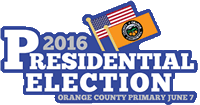Election NewsClicks
Behind the Scenes
of Orange County Elections

May 20, 2016 - As the June Primary rapidly approaches, we have been busy analyzing data in order to determine the right number of voting booths per polling location. Since 2007 we have used extensive turnout history and data to customize the number of booths at each site (to match the level of demand).
Now we are taking it one step further with some help from the brainpower at the Massachusetts Institute of Technology (MIT). We used our current methodology first:
- Voters who voted at the polls in the Primary of 2012, multiplied by 1.9 to account for a similar percentage of turnout for the Primary 2008 Election.
- Registered voters, multiplied by .6 to account for 60% turnout of all registered voters.
- To account for the turnout per hour, we divided the projected turnout by 8 hours. Although there are 13 voting hours, we used 8 to account for higher turnout times of the day.
- To determine the time it takes to vote, we did an internal time test with 28 voters, and used the average time (5 minutes).
Then we incorporated our analysis into the MIT spreadsheet that was developed to assist election officials with determining the optimum number of booths per site (to ensure the highest possible service times):
- We set a desired wait time for voters to be 5 minutes, with a 90% service level (meaning that 90% of all voters would be able to vote within 5 minutes).
- We then entered the data from our analysis to determine the number of voting booths needed, with the above numbers as the input.
- According to the results, any polling place that required over 8 booths, we allocated 12 booths. Any polling place that required 8 booths or under, we allocated 8 booths.
This level of increased analysis allows us to target specific polling places (on a granular level) where demand for in-person voting is expected to be higher, reducing the likelihood of long wait times. We will be collecting additional data on Election Day to assist us in further refining this process for November.